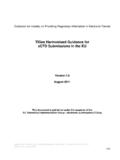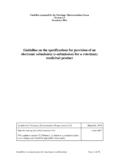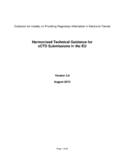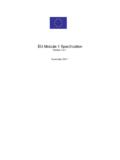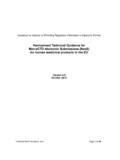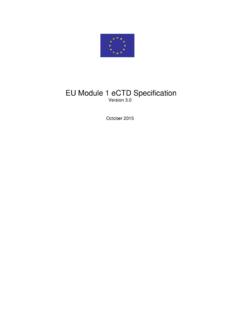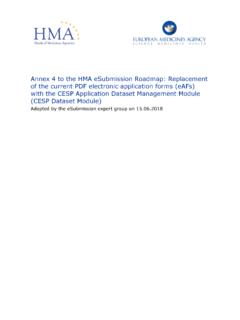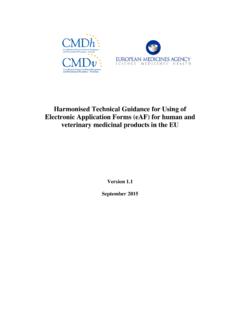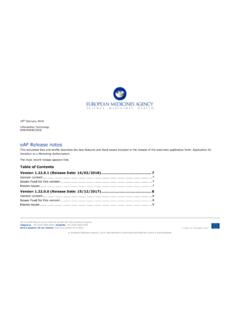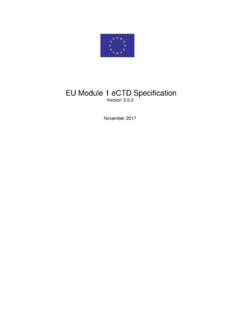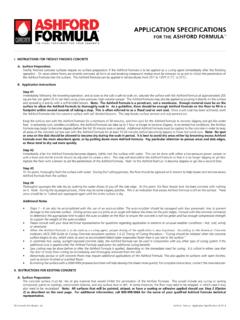Transcription of Guideline on the specifications for provision of an ...
1 Guideline on specification for veterinary e-submissions Page 1 of 19 Guideline prepared by the Veterinary Harmonisation Group Version December 20165 Guideline on the specifications for provision of an electronic submission (e-submission) for a veterinary medicinal product Adoption by Veterinary Harmonisation Group (version ) December 20165 Date for coming into effect (version )* *For update in section 7(f) Renewal, it relates to a correction rather than a change and should be applicable immediately. 1 July June 20162017 Guideline on specification for veterinary e-submissions Page 2 of 19 Introduction .. 3 1 Scope .. 3 2 Procedures for sending electronic information .. 3 2.(a) Portals .. 4 2.(b) Eudralink .. 4 2.(c) Hard media (CD/DVD) .. 4 3 Language.
2 5 4 File Format & Source .. 5 5 Requirements for creating PDF files for electronic submission .. 5 5.(a) Electronic source documents .. 5 6 Signatures .. 6 7 Structure of the electronic submission .. 6 7.(a) General considerations .. 6 Root folder .. 6 Folder "add-info" (additional information) .. 7 Adaptation of folder structure .. 7 Folder names .. 8 7.(b) Folder structure for initial Marketing Authorisation Application .. 8 7.(c) Use of summary reports in MRL dossier .. 8 7.(d) Submission structure for updates during assessment phase .. 8 Validation updates .. 8 Responses to Questions .. 9 7.(e) Active Substance Master Files .. 9 7.(f) Submission structure for post-authorisation submissions .. 10 Variations / Extensions .. 10 Renewals .. 10 Other post authorisation submissions .. 10 7.(g) Indexing.
3 10 Navigation via GTOC only: .. 11 Navigation via GTOC and part-specific TOCs: .. 11 7.(h) Files .. 12 Size and number .. 12 Naming .. 12 Bookmarks and hyperlinks (outside the GTOC or TOC) .. 13 8 Security .. 13 9 Technical validation .. 14 10 Glossary .. 15 TA B LE 1: Folder structure and Standard files for an electronic application for a pharmaceutical product .. 16 TA B LE 2: Folder structure and Standard files for an electronic application for an immunological product .. 17 TA B LE 3: Folder structure and Standard files for an electronic MRL application .. 18 TA B LE 4: Recommended country codes for country-specific folders when a file is submitted to only one country .. 19 Guideline on specification for veterinary e-submissions Page 3 of 19 Introduction This Guidance Document is intended to assist applicants and regulators with submissions of dossiers in electronic format.
4 It specifies the basic parameters required for an acceptable electronic submission to be known as Veterinary NeeS (VNeeS), the name being inspired by the established NeeS standard for Human medicinal products. The document has been reviewed by the Veterinary Harmonisation Group, an evolution of the former TIGes-Vet Sub Group which is made up of representatives from National Competent Authorities, the EMA and Industry. All National Competent Authorities and EMA should adopt this guidance as the basis for their acceptance of electronic submissions for marketing authorisations from applicants. At a meeting in July 2007 the HMA recorded the following decision, In response to a direct request from industry, HMA confirmed that the requirement for authorities to be in a position to accept electronic only submissions by 2009 applied to veterinary as well as to human applications.
5 It should be understood that the investment of resources by the Industry will also depend on progress made by the authorities. This decision meant that authorities had to be able to accept electronic submissions from 1 January 2010 as well as continuing to deal with submissions based on paper. The work will continue to achieve a harmonised way of electronic working by all NCAs. The final adopted version of the HMA eSubmission Roadmap was endorsed by the EU Telematics Management Board on the 1st of October 2014, and describes the situation of eSubmission in the European Union at that time and the issues that will be addressed in the near future. The roadmap includes a number of initiatives such as dossier formats, portal solutions and application forms.
6 An annex to this roadmap describes the requirements that have to be fulfilled in order to use and accomplish the following deliverables: VNeeS only for New MAA in DCP and CP by Q1 2016 VNeeS only for all submissions in EU procedures by Q1 2017 1 Scope This guidance covers all types of initial applications for marketing authorisation made in the Centralised (CP), Mutual Recognition (MRP), Decentralised (DCP) and National procedures including updates provided during the assessment phase (validation updates and responses to questions). It applies also to active substance master files (ASMF), MRL applications, and post-authorisation submissions ( variations and extensions, PSUR submissions, renewal applications and dossiers for referral procedures).
7 For procedures such as requests for Scientific Advice, parallel import or field trial applications, the use of an electronic dossier is feasible in principle, if accepted by the competent authority. The requirements should follow the current Guideline , except for the folder structure. For notifications submitted regarding the deliberate release of a Genetically Modified Organism (GMO), it is advisable to confirm acceptance of an e-submission with the concerned national agency. 2 Procedures for sending electronic information There are different ways of submitting electronic dossiers to competent authorities, including portals, Eudralink or hard media (CD/DVD), if accepted by authorities. Normally, only one way should be used, to avoid sending multiple copies of the same submission to the authority.
8 Competent authorities will not accept any hardware (laptops, desktops, etc.) or software from applicants in connection with the submission of information in an electronic format. The electronic information should be directly readable and usable on the competent authorities hardware ( CD/DVD drive) and software. Guideline on specification for veterinary e-submissions Page 4 of 19 Authorities may require provision of a paper cover letter for electronic submissions via hard media, portals or Eudralink. An electronic version of a cover letter should always be included in the folder add-info of the VNeeS submission (PDF preferably generated from text source without a requirement to scan a wet signature).
9 For authorities requiring an official signature for legal reasons, an originally signed cover letter or application form may accompany or follow the electronic submission. See CMDv website for further details on NCA requirements. For submissions to the EMA, please refer to the eSubmission section of the Agency website. 2.(a) Portals It is strongly recommended to use secure portals for the submission of applications. For submissions to national competent authorities (CP or MRP/DCP), the Common European Submission Platform (CESP) can be used for many types of veterinary submissions and is accepted by many authorities, please refer to the CESP website for further details. The EMA eSubmission Gateway/Web Client may be used only for submissions to the EMA in the Centralised Procedure.
10 For further details see the eSubmission website. 2.(b) Eudralink Eudralink has a size limit for attached files, refer to the EudraLink User Guide for further details. As it is not recommended to split a VNeeS submission, it is unlikely that an e-submission of a complete dossier can be made by this means. If accepted by the competent authority, Eudralink may be used for email communication with the authorities, for submission of smaller applications and responses, and for the exchange of editable versions of the product information (SPC, label, leaflet). Folder-structured submissions via Eudralink have to be submitted as a zip file. Applicants should ensure that the correct e-mail addresses intended for submission via Eudralink are used. When using Eudralink, it is important that the expiry date is set to an appropriate length to ensure that the message can be opened during the procedure.
